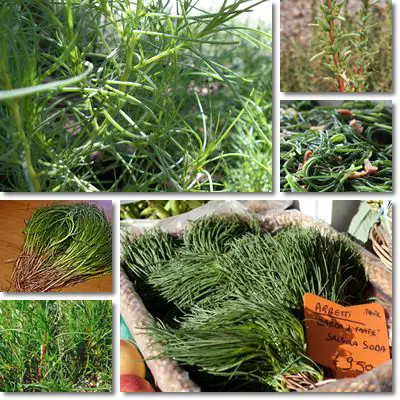Salsola soda is the scientific name for the popular Mediterranean shrub-like plant called agretti, friar’s beard or opposite-leaved saltwort.
Agretti is highly valued for its detoxifying action, laxative and anti-aging properties as well as dense nutritional value.
Agretti is the Italian name for the Salsola soda plant.
The Italian term appears to prevail in the English speaking world due to the growing popularity of both the Mediterranean diet and of Italian cuisine and in an attempt to avoid confusion between it and saltwort plants.
What is agretti and where can it be found?
Agretti is a shrub-like plant from the Mediterranean Basin. It is used as a culinary vegetable and currently enjoys great popularity, mainly due to its novelty and lively leafy green flavor. Agretti plants thrive in coastal regions with high salinity and can be found all over the Mediterranean basin, along the Black Sea coast, on the Atlantic coast of Portugal as well as on the Pacific coast of North America (especially in California), according to Peter Baye in Newsletter of the California Exotic Pest Plant Council, Vol. 6, Nr. 4, 1998.

Other popular Italian names for the agretti plant include barba di frate and liscari sativa or lischeri. English names for agretti include barilla plant, opposite-leaved saltwort, monk’s beard, friar’s beard, goat’s beard and opposite-leaf Russian thistle.
What does agretti look like?
According to Wikipedia, agretti is a shrub-like plant growing to a maximum of 70 cm in height. Plants have long, reddish roots, either green or red-tinted stems and meaty, needle-shaped, green leaves. Although young leaves have a needle-like appearance, they grow to impressive lengths of over 30 cm. They are usually harvested when they reach 10 cm in length and cut periodically to stimulate leaf growth.
What does agretti taste like?
Culinary speaking, agretti refers to the edible leaves of the Salsola soda plant and is regarded as a spring vegetable. Raw agretti leaves are tender and have a slightly acidic and salty taste, with a grassy undertone and a crisp, but succulent and fleshy texture.
They are often steamed or boiled until soft, no more than 10-15 minutes and served with lemon slices and olive oil. Cooked agretti leaves taste somewhat like spinach, but with a pleasant and invigorating tart flavor and a bit more crunch than the all-mushy leafy green.
As far as its nutritional value is concerned, agretti is an excellent natural depurative and laxative, rich in essential nutrients such as calcium, iron, vitamins A, C and K as well as antioxidant compounds. Agretti is related to spinach, chard, beetroot and quinoa and boasts several great health benefits. Find out below what are the top 6 nutrition facts and health benefits of agretti, also known as opposite-leaved saltwort.

What is agretti good for?
Depurative action
Agretti has a strong cleansing effect on the body, helping remove toxins and regulating bodily functions. According to traditional Chinese medicine, agretti helps purify the blood as well. I can tell you from experience that if you eat even just one healthy serving of the vegetable, you are going to take at least one good trip to the bathroom.
Natural laxative properties
Like most greens, agretti is a good source of dietary fiber, indigestible plant compounds that help regulate intestinal transit time and add bulk to stools, stimulating peristalsis and relieving constipation. Agretti with a bit of lemon juice and olive oil makes a great constipation remedy that will empty and cleanse the intestines like no other. However, lemon juice is best consumed occasionally because the acidic compounds in it can damage tooth enamel and lead to sensitive teeth.
Good source of essential vitamins
The beautiful, deep green color of agretti leaves indicates they are a good source of vitamins A and K. The invigorating sour or acidic taste indicates the presence of generous amounts of vitamin C. However, it’s best to remember that cooking heat destroys vitamin C in food, which is why we are better off either limiting cooking time or consuming vitamin C-rich foods raw if we want to enjoy the health benefits of the nutrient.
Good source of dietary minerals
Just like its relatives, spinach and chard, agretti is a good source of essential minerals such as calcium and iron. While calcium contributes to strong bones and teeth, iron helps reduce fatigue associated with iron deficiency and anemia and contributes to the formation of red blood cells.
Supports bone remineralization processes
The combination of bone-friendly vitamins and minerals such as vitamin K and calcium, along with the pigment chlorophyll in agretti is a prerequisite for strong, healthy bones as the nutrients contribute immensely to bone (and teeth) remineralization processes.
Exhibits anti-aging effects
Many 80 and 90-year-olds in Italy indulge in agretti when in season and claim they owe their longevity, in part, to this lovely spring vegetable. Indeed, agretti is a great source of essential nutrients with powerful antioxidant properties such as vitamins C, A and K.
